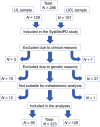The role of dopaminergic medication and specific pathway alterations in idiopathic and PRKN/PINK1-mediated Parkinson's disease
- PMID: 40367158
- PMCID: PMC12077494
- DOI: 10.1126/sciadv.adp7063
The role of dopaminergic medication and specific pathway alterations in idiopathic and PRKN/PINK1-mediated Parkinson's disease
Abstract
Parkinson's disease (PD) is the second most common neurodegenerative disease, with a rapidly increasing prevalence worldwide. Biomarkers monitoring state and progression are urgently needed, and metabolomics from easily accessible biofluids holds the potential to elucidate pathophysiological underpinnings in PD. Several studies suggested metabolomic differences between patients and controls, but findings are controversial, and independent replication is scarce. We thus applied state-of-the-art, large-scale metabolomics in patients with idiopathic and monogenic PD and controls from two independent samples, analyzed by a strict meta-analysis approach. Thereby, we (i) debunked that l-Dopa medication and not disease status causes the most substantial metabolomic differences and (ii) identified polyamine metabolism alterations, partly, but not entirely associated with l-Dopa treatment. Furthermore, we found explorative but robust evidence for alterations in endocannabinoid metabolites; detected lipid metabolism alterations, highlighting potential crosslinks with alpha-synuclein pathology; and provided evidence for a metabolomic signature for the role of oxidative damage in patients with PRKN- and PINK1-linked PD.
Figures




Similar articles
-
Mitochondrial damage-associated inflammation highlights biomarkers in PRKN/PINK1 parkinsonism.Brain. 2020 Oct 1;143(10):3041-3051. doi: 10.1093/brain/awaa246. Brain. 2020. PMID: 33029617 Free PMC article.
-
Intestinal infection triggers Parkinson's disease-like symptoms in Pink1-/- mice.Nature. 2019 Jul;571(7766):565-569. doi: 10.1038/s41586-019-1405-y. Epub 2019 Jul 17. Nature. 2019. PMID: 31316206
-
Plasma and urinary metabolomic signatures differentiate genetic and idiopathic Parkinson's disease.Brain Res. 2025 Jul 1;1858:149625. doi: 10.1016/j.brainres.2025.149625. Epub 2025 Apr 17. Brain Res. 2025. PMID: 40204143
-
The impact of reactive oxygen species and genetic mitochondrial mutations in Parkinson's disease.Gene. 2013 Dec 10;532(1):18-23. doi: 10.1016/j.gene.2013.07.085. Epub 2013 Aug 15. Gene. 2013. PMID: 23954870 Review.
-
Therapies for Genetic Forms of Parkinson's Disease: Systematic Literature Review.J Neuromuscul Dis. 2021;8(3):341-356. doi: 10.3233/JND-200598. J Neuromuscul Dis. 2021. PMID: 33459660 Free PMC article.
Cited by
-
Application of IVDr NMR spectroscopy to stratify Parkinson's disease with absolute quantitation of blood serum metabolites and lipoproteins.Sci Rep. 2025 May 22;15(1):17738. doi: 10.1038/s41598-025-01352-0. Sci Rep. 2025. PMID: 40404791 Free PMC article.
References
MeSH terms
Substances
LinkOut - more resources
Full Text Sources
Medical

